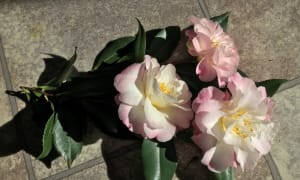
Mistletoe uses birds to pollinate the flowers and disperse the seeds. Photo: Supplied

Mistletoe relies on their hosts for water and nutrients. Photo: Supplied
David Watson a Professor of Ecology for 20 years has a passion for Mistletoe and gave a talk on the much-maligned parasitic plant.
He was able to dispel a few long-held myths about the mistletoe and about its ecological function and importance in the landscape.
Mistletoes are native plants on native trees.
They are parasitic plants – instead of obtaining nutrients and water directly from the soil through roots they take them from other plants.
Relying on their hosts for their water and nutritional needs, most parasitic plants manufacture their own carbohydrates using photosynthesis.
Mistletoes attach to their hosts above ground thereby freeing them from soil completely. Thus, they can be described as shrubby, aerial hemiparasite.
It is an ancient marriage between trees and mistletoe that has been going on for 55 million years.
There are specific mistletoes for Acacias (as we saw in the Boree) Banksia, Callitris, Hakeas and even Mangroves host their own species of mistletoe.
Despite popular opinion mistletoe is actually a useful plant.
Many animals use it for food and for nesting.
Studies have shown areas with more mistletoe have a greater diversity and number of animals.
The threatened Painted Honeyeater and the Superb Parrots eat it.
Many little birds like thornbills and honeyeaters rely on the thick clumps for nesting sites. Some butterflies lay eggs on mistletoe and the caterpillars help to control it.
Interestingly, the Brush tailed Possum relies on it for food and at the same time controls it. As Brushtailed Possums have declined in number due to habitat destruction and removal of nesting hollows the mistletoe can grow uncontrollably.
Fire destroys mistletoe and as we quickly try to control fires we also allow the mistletoe to grow uncontrollably by these practices.
David said mistletoe was not a thief, it is a borrower.
It drops leaves on the ground faster than other trees. The litter is filled with nutrients which supports and improves microbial, fungal and insect activity on the ground.
Mistletoe creates microclimates. If you feel the leaves they are cool – the mistletoe lets water weep out of its leaves slowly to cause this. Other partial parasites like quandong and sandlewood also do this.
Mistletoe uses Mistletoebirds to pollinate its flowers and disperse the seeds. Movement and nesting of this little black and red bird is timed with peak fruit availability. The seeds are sticky and when it deposits the seed it sticks firmly on the branch of a tree from where it sprouts. It will not sprout on your clothes line though.
Often the single paddock tree is full of mistletoe and we slowly see it die. True, if a tree has more than 30 per cent mistletoe in the canopy that’s too much.
This could be because all the insects and birds and possums have not been able to get to it to control some of the mistletoe.
It might also be because the roots are disturbed continuously by cultivation and by the herbicides commonly used. We can’t blame mistletoe for tree death but ourselves for disturbing the equilibrium in nature.
We were all informed greatly and came away with a greater respect for these much-maligned plants and about their important ecological function in the landscape. Thanks David Watson and Kathy Tenison from Murrumbidgee Landcare for organising it all.





